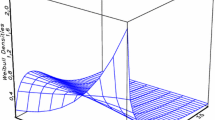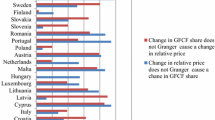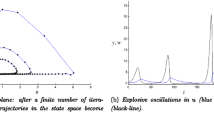Abstract
Survey data are used to investigate the very long spending lags estimated in neoclassical studies of investment expenditures. Neoclassical investment theory has trouble explaining the length of these lags. By recognizing the Austrian concept of the capital structure and applying it to the problem, the present paper explains the length of these lags as proceeding from interactions between types of capital. Austrian arguments stemming from Austrian business-cycle theory seem to be needed to explain these lags.
Similar content being viewed by others
References
Abel, A. B. and Blanchard, O. J. (1988). “Investment and Sales: Some Empirical Evidence.” In Barnett, W. A., Berndt, E. R., and White, H. (Eds.), Dynamic Econometric Modeling (Proceedings of the Third International Symposium in Economic Theory and Econometrics). Cambridge, England: Cambridge University Press.
Asanuma, M. and Newman-Smith, A. (1993). “Setting Up a Built-In Evaluation System When Sample Design Uses an Imperfect Frame.” U.S. Department of Commerce, Construction Statistics Division. Working paper.
Bernanke, B., Bohn, H. and Reiss, P. (1988). “Alternative Non-Nested Specification Tests of Time-Series Investment Models.” Journal of Econometrics37, 293–326.
Bischoff, C. (1971). “Business Investment in the 1970s: A Comparison of Models.” Brookings Papers on Economic Activity1, 13–58.
Callahan, G. and Garrison, R. W. (2003). “Does Austrian Business Cycle Theory Help Explain the Dot-Com Boom and Bust?” Quarterly Journal of Austrian Economics6(2), 67–98.
Clark, P. K. (1979a). “Investment in the 1970s: Theory, Performance, and Prediction.” Brookings Papers on Economic Activity, 73–113.
Clark, P. K. (1979b). “Comments and Discussion.” Brookings Papers on Economic Activity, 120–121.
Friedman, M. (1968). “The Role of Monetary Policy.” American Economic Review58, 1–17.
Friedman, M. (1969). “The Lag in Effect of Monetary Policy.” In Friedman, M., The Optimum Quantity of Money and Other Essays, 237–260. Chicago: Aldine Publishing Company.
Garrison, R. W. (2001). Time and Money: The Macroeconomics of Capital Structure. London: Routledge.
Gordon, S. (1992). “Costs of Adjustment, the Aggregation Problem and Investment.” Review of Economics and Statistics74, 422–429.
Greenspan, A. (1979). “Comments and Discussion.” Brookings Papers on Economic Activity, 114-117.
Hayek, F. (1932). Prices and Production. New York: The MacMillan Company.
Hayek, F. (1975a [1933]). Monetary Theory and the Trade Cycle. New York: Augustus M. Kelley.
Hayek, F. (1975b [1937]). “Investment That Raises the Demand for Capital.” In Profits, Interest and Investment. New York: Augustus M. Kelley, pp. 73–82.
Hubbard, R. G. (1994). “Investment under Uncertainty: Keeping One's Options Open.” Journal of Economic Literature32, 1816–1831.
Hughes, A. M. (1997). “The Recession of 1990: An Austrian Explanation.” Review of Austrian Economics10, 107–123.
Jorgenson, D. W. (1963). “Capital Theory and Investment Behavior.” American Economic Review53 (May: Supplement), 247–259.
Jorgenson, D. W. (1965). “Anticipations and Investment Behavior.” In Duesenberry, J. S., Fromm, G., Klein, L. R., and Kuh, E. (Eds.), The Brookings Quarterly Econometric Model of the United States. Chicago: Rand McNally, pp. 34–92.
Jorgenson, D. W. (1967). “The Theory of Investment Behavior.” In Ferber, R. (Ed.), Determinants of Investment Behavior. New York: National Bureau of Economic Research, pp. 129–55.
Jorgenson, D. W. (1971). “Econometric Studies of Investment Behavior: A Survey.” Journal of Economic Literature9, 1111–1147.
Jorgenson, D. W. and James A. Stephenson (1967). “The Time Structure of Investment Behavior in United States Manufacturing, 1947–1960.” Review of Economics and Statistics49, 16–27.
Keeler, J. P. (2001a). “Empirical Evidence on the Austrian Business Cycle Theory.” The Review of Austrian Economics14, 331–351.
Keeler, J. P. (2001b). “Relative Prices and the Business Cycle.” Unpublished manuscript.
Kopcke, R. W. (1985a). “The Determinants of Investment Spending.” New England Economic Review(July/August), 19–35.
Kopcke, R. W. (1985b). “Investment Spending and the Federal Taxation of Business Income.” New England Economic Review(September/October), 9–33.
Kopcke, R. W. (1993). “The Determinants of Business Investment: Has Capital Spending Been Surprisingly Low?” New England Economic Review(January/February), 3–31.
Lachmann, L. M. (1977 [1940]). “A Reconsideration of the Austrian Theory of Industrial Fluctuations.” In Lachman, L. M., Capital, Expectations, and the Market Process: Essays on the Theory of the Market Economy. Kansas City, Missouri: Sheed Andrews and McMeel, Inc., 1977, pp. 267–288.” Originally published in Economica7, 179–196.
Lachmann, L. M. (1977 [1947]). “Complementarity and Substitution in the Theory of Capital.” In Lachmann, L. M., Capital, Expectations, and the Market Process: Essays on the Theory of the Market Economy. Kansas City, Missouri: Sheed Andrews and McMeel, Inc., pp. 197–213. Originally published in Economica14, 108–119.
Mayer, T. (1958). “The Inflexibility of Monetary Policy.” Review of Economics and Statistics 40, 358–74
Mayer, T. (1960). “Plant and Equipment Lead Times.” Journal of Business 33, 127–132.
Mises, L.V. (1966 [1949]). Human Action: A Treatise on Economics. Chicago, IL: Contemporary Books.
Montgomery, M. R. (1995) “‘Time-To-Build’ Completion Patterns for Nonresidential Structures, 1961-1991,” Economics Letters, 48(2), 155–163.
Montgomery, M. R. (1996). “‘Time-To-Build’ Progress Patterns for Nonresidential Structures, 1961-1991,” Rivista Internazionale di Scienze Economiche e Commerciali 43(1): 41–62.
Montgomery, M. R. (1997). “The Persistence of Producer Durables: ‘Own’ Time-To-Build or Capital Complementarity?” Rivista Internazionale di Scienze Economiche e Commerciali 44(2), 339–360.
Mulligan, R. F. (2002). “A Hayekian Analysis of the Term Structure of Production.” The Quarterly Journal of Austrian Economics5(2), 17–33.
Naylor, J. A. (1985). “A Survey of Post-1970 Empirical Studies of Investment Expenditures.” In Modern Concepts in Macroeconomics, T. M. Havrilesky (Ed.), Arlington Heights, IL: Harlan Davidson Inc., pp. 27–55.
Oliner, S., Rudebusch, G. and Sichel, D. (1995). “New and Old Models of Business Investment: A Comparison of Forecasting Performance.” Journal of Money, Credit and Banking27(3), 806–826.
“Purchasing's Leadtimes.” Purchasing, various issues.
Rottenberg, I. and Donahoe, G. (1971). “Improved Deflation of Producers' Durable Equipment.” Survey of Current Business55: 20-23, 28.
Sargent, T. J. (1993). Bounded Rationality in Macroeconomics. Oxford: Clarendon Press.
Spanos, A. (1990). “Towards a Unifying Methodological Framework for Econometric Modelling.” In Modeling Economic Series: Readings in Econometric Methodology, Granger, C. (Ed.), Oxford, U.K.: Clarendon Press, pp. 335-364.
U.S. Department of Commerce (1997). Economic Report of the President, 1996. Data Appendix.
U.S. Department of Commerce, Construction Statistics Division (various issues). Construction Reports: Value of New Construction Put in Place (Series C30). January 1970, October 1971, December 1978, August 1979, August 1980, August 1981, August 1984.
U.S. Department of Commerce, Construction Statistics Division (1992). Current Construction Reports: Value of New Construction Put in Place(Series C30), October.
Wainhouse, C. E. (1984a). Hayek's Theory of the Trade Cycle. The Evidence from the Time Series. Ph.D. dissertation, New York University.
Wainhouse, C. E. (1984b). “Empirical Evidence for Hayek's Theory of Economic Fluctuations.” In Money in Crisis: The Federal Reserve, the Economy, and Monetary Reform, Siegel, B. N. (Ed.). San Francisco, CA: Pacific Institute for Public Policy Research, pp. 37-71.
Zarnowitz, V. (1973). Orders, Production, and Investment–A Cyclical and Structural Analysis. New York: National Bureau of Economic Research.
Author information
Authors and Affiliations
Corresponding author
Additional information
JEL Code E3, E4, C1
Rights and permissions
About this article
Cite this article
Montgomery, M.R. Austrian persistence? Capital-based business cycle theory and the dynamics of investment spending. Rev Austrian Econ 19, 17–45 (2006). https://doi.org/10.1007/s11138-006-6092-x
Issue Date:
DOI: https://doi.org/10.1007/s11138-006-6092-x




